In October 2025, artist Thu Tran (Tran Thi Thu) and her colleagues, including artist Tay Phong, artist Le Thi Minh Tam, and artist Nguyen Tran Thao Nguyen, created an art project: installation-painting " Xong Chu Xon Xao " in Son La on the occasion of the 130th anniversary of the province's founding. It was a wish for rebirth inspired by the epic poem "Farewell to the Lover" of the Thai people.
From "Xong chu xon xao" to "Pieu du"
- Madam, as an artwork appearing on the occasion of the 130th anniversary of the founding of Son La province, why did you choose the theme "Xong chu xon xao" with the meaning of "sending off a lover" as the theme for your work?
Artist Thu Tran: " Xong chu xon xao " is a lyrical narrative work of the Thai people about the love fate of a couple who loved each other deeply but could not marry each other, and then only when they were about to reach the end of their lives, did the couple find each other and were reborn in a late fate.
Inspired by that eternal love, the installation-painting “ Xong chu xon xao ” wants to recreate a love story that was separated, a journey of preserving, waiting and reuniting a couple who loved each other deeply but were separated by prejudice and customs. After many years apart, they found their way back to each other not in tears, but with loyalty, silence and tolerance.
“ Xong chu xon xao ” is the quintessence of cultural, artistic and spiritual life of the Thai people, the indigenous inhabitants of the mountainous region of Son La for generations. Therefore, in the great festival of Son La province, there is nothing more appropriate than honoring the spiritual values of the Thai people.
However, not only that, other material and spiritual values of the Thai people such as the Piêu scarf, weaving, sewing, and traditional embroidery are also used as materials for this work of art with the exhibition of installation art, performance art and painting called " Piêu du. "
- "Pieu du," what a strange name, is this also a Thai name like "Xong chu xon xao"?
Artist Thu Tran: No, it was just an idea that flashed in my uncertain consciousness. “Pieu” is the Thai people’s Pieu scarf, a wedding gift, a promise, a girl’s luggage when she goes to her husband’s house, each hand-embroidered scarf is a message of affection.
Therefore, the Piêu scarf is an affirmation of a woman’s dignity and skillful, hard-working hands, and at the same time a ritual, a memento, a status, and even an aspiration. But in Vietnamese, the sound “Piêu” sounds similar to the word “Phiêu” in “phiêu lang” or “phiêu trôi” (wandering), so from there “Piêu du ” was formed.
The girl in “ Xong Chu Xon Xao ” also embroidered a scarf for herself, sending into it many beautiful wishes about love, marriage and life. However, her love was broken, she had to marry someone else, and had to wander from one house to another. She was no different from the pink embroidered scarf blown away by the wind, not knowing where, having to endure the “wandering” situation for almost her entire life.
When I look at each strip of fabric, each embroidery on the Piêu scarves, I see a wordless stream of memories. Fabric and thread can speak, through patterns, through the rhythm of the needle, through the colors of time. It is the deepest language of a culture.
“ Pieu du ” is an attempt to bridge the past and the present, between cultural identity and contemporary form. It is a praise for the virtue, resilience and human beauty of Thai women. It is a journey not only to see, but also to listen, feel and sew together the dreams that have fallen.
The red thread is a symbol of fate, of the connection between people, between the past and the present. The opening space is like a dreamland - where the dream of love begins to be woven. Sewing the old dream is not to return, but to be reborn. Art is like an act of healing, like the woman's hands sewing each thread to reconnect life, reconnect humanity, reconnect love.
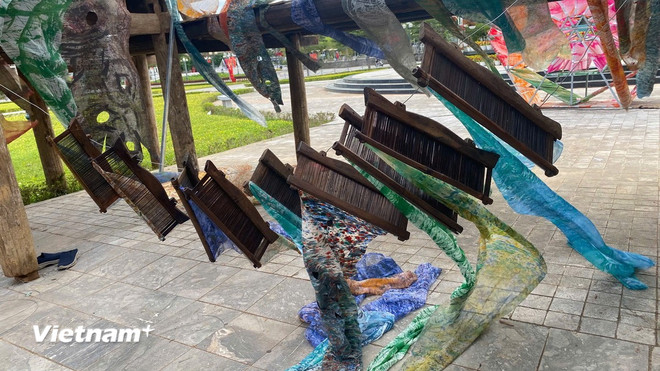
Every day, I return to the familiar action: holding a needle, threading the thread, sewing each small stitch on a long silk background. Each needle stroke seems to be moving, slowly pushing the painting story towards completion, not in a realistic or linear way, but in an abstract language, where painting and sewing intertwine, suggestively.
It is these unbroken stitches that create another space for the painting: a space of pauses, silences, and whispers of disturbance. On the silk background of several dozen meters long, the story does not appear completely but is hidden and inviting.
Perhaps thanks to that incomplete disclosure, the painting becomes strangely intimate, as if the viewer is not standing outside, but is accompanying me, stitching a part of the dream with me. I do not stitch alone, in the journey of drawing and stitching, I invite my sisters to sit with me, thread the thread, tie knots, and connect the separate pieces of the painting and the soul.
We are not only completing a work together, but also reviving something very old, the gentle and enduring presence of Vietnamese women in general and of Thai ethnic women in particular.
Every needle that passes through is an act of sharing, every thread is a connection: between people, between the present and the past, between individuals and the community. My grandmother, my mother, my sister, my younger siblings and my friends - they are not outside my art, they are part of it, I am grateful for their presence, grateful for the love that is stitched into shape.
A big stitch
- Re-sewing the spring dream picture, re-sewing the old cloth strips, re-sewing the broken home, is the wish for rebirth of you and the group of artists only contained in one identity, one story or one community?
Artist Thu Tran: Today’s world is filled with an abundance of material surplus, memories, and even forgotten legacies. Things that were once closely associated with human life, such as a weaving tool, a stilt house, or an ancient song, are gradually becoming “relics” amid the flow of modernity. But is that surplus just waste, or the material for a new life?
I believe that rebirth does not belong to anyone, with an attitude of awareness and gratitude, we can touch those legacies, listen to them, and let them continue to tell their story, in a new form, a different life. From the tragic song “ Xong chu xon xao ” to the creative journey “ Pieu du ,” I used silk, red thread, and my hands to sew, to connect, to redraw a cultural journey.
The old stilt houses, about 150 “phum” – a part of the Thai people’s loom – are now present in a contemporary art form where painting-installation-performance meet, interact and tell stories. If you follow my creative journey, you will see a big stitch.
From the exhibitions “ Return,” “Call,” “Spreading Silk, ” to “ Wandering ” today, I am gradually weaving an emotional map, a cultural network, where each work is a highlight on the fragile, but durable red thread of memory and identity.
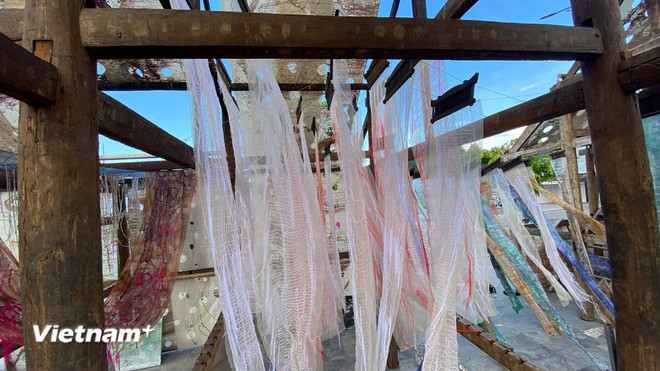
And in this “ Piêu du ” exhibition, it is not just an exhibition but a journey to find identity, to revive heritage, and to awaken personal cultural awareness in an age of excess. The connection between the past and the present, things that cannot be expressed in words, but can be touched through the works to express cultural awareness and connection.
The feelings, memories, promises and even the nameless pain of women who lived, loved, wove and silently disappeared, sewing and drawing, are not just techniques, but ritual acts, a way for me and the women who accompanied me, to reweave the map of our souls.
“ Pieu du ” is not only a visual exhibition, it is a ritual of reincarnation. I recreated wooden floor spaces, hung painted and sewn silk paintings, and put into them the singing, the mouth harp, the flute, and the breath of the Northwest mountains and forests.
Here, painting-installation-performance are not three separate fields, but three interwoven breaths, creating a lively and poetic art space.
We create this art space as an invitation: come with me into “ Xong chu xon xao ” to listen again, touch again, live again, with the heart, with the breath, with each slender red thread, but never broken, “Pieu” is no longer wandering, no longer lost, but has become the way back to one’s family and people.
"Xong chu xon xao" is an invitation to return to the roots.
- The stage is a stilt house, but it is not complete but separated into 2 blocks? How can your artistic intention be expressed here?
Artist Thu Tran: In the story “ Xong chu xon xao ” there is a silent pain that seeps through every thatched roof, every bamboo wall, every wooden staircase of the old stilt house. There, a Thai girl sings a farewell song, not only to the person she loves, but also to the roof, the mountain, the fireplace, and her own fate.
The stilt house, built by the hands of men, is where women keep the fire. Where every long night the sound of weaving blends with sighs. Where words are sung like a lullaby, like a call, like a farewell to a loved one. Today, when the stilt houses are abandoned, replaced by brick houses, corrugated iron roof houses, red tiled roof houses… will the memories still remain?
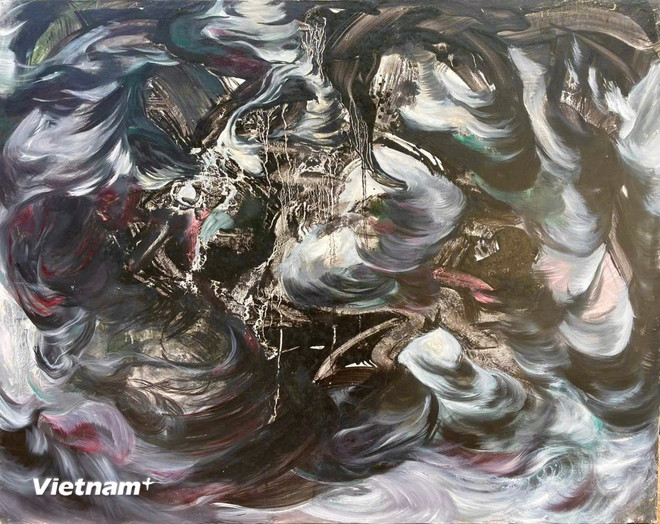
In my work “ Xong chu xon xao ”, the stilt house is not only reconstructed as a physical structure. But it is evoked as a cultural spirit, a place where time is sewn together with red thread-painted silk-needlework-artistic behavior.
The old pillars bear the handprints of ancestors, the worn steps bear the footsteps of mother, the torn walls are patched with embroidery, songs are sung everywhere, and the sound of the mouth harp. The old house is not restored, but revived, in the flow of contemporary art.
The two blocks of houses may look separate like two characters in the story “ Xong Chu Xon Xao ,” but in fact they have reunited in a unified entity, “one house,” with the stitches being strips of fabric flowing down from 150 “phums.” Therefore, the stilt house in the work “Xong Chu Xon Xao” is not just a farewell, but becomes a ritual of re-union.
- So how was the collaboration between you and the three artists and painters who worked on this work?
Artist Thu Tran: As you can see, the work “ Xong chu xon xao ” is not only a visual art space but also a journey of deep connection between generations, creative forms and like-minded artistic souls. We listened to each other, walked together, and together wrote a symphony of art and attachment to this sacred land.
Alongside my installation-painting works, there is also the co-installation of performance artist Tay Phong, who brings a language of body expression and music , rich in symbolism, connecting the present breath with the cultural depth of the Thai people of the Northwest.
His movements in the space, ideas and arrangements, to me, are a harmony that creates a unified structure and form throughout the creative process, from the exhibition space to the performance space.
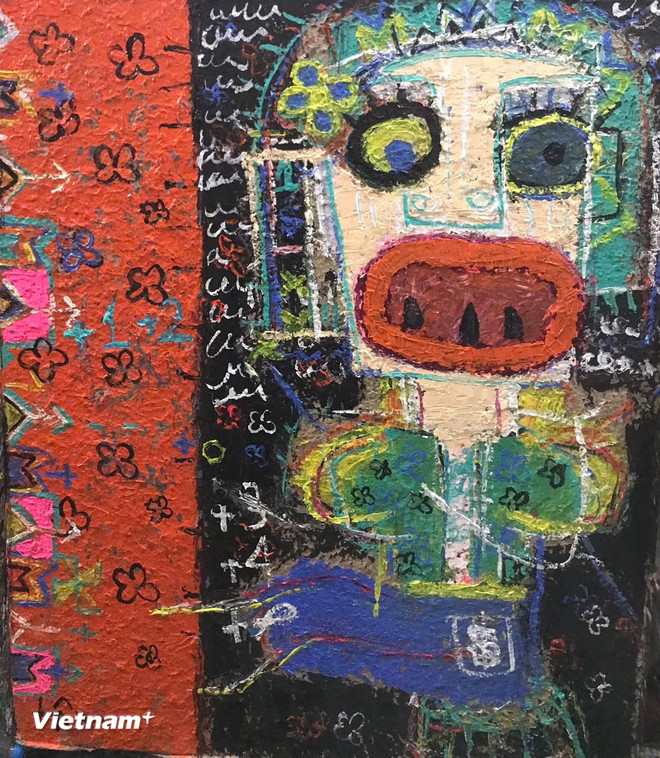
Also participating in the exhibition is artist Le Thi Minh Tam, whose strong and bold expressive style depicts the inner beauty and body of Thai women as a symbol of divine vitality and real life, endurance in the wilderness.
Along with Nguyen Tran Thao Nguyen, a member of the young 9X generation of artists, brought a new but sophisticated perspective on the forest where she was born in the language of abstraction. The two female artists introduced 17 paintings on canvas, like two visual streams intersecting and supporting each other in the artistic journey called " Pieu du ."
It is the meeting of artistic personalities from expression, performance to installation that has created a space imbued with the spirit of resonance. Each work, each movement, each color in the exhibition is a piece of the common story: the journey of returning, connecting, preserving and recreating love for the Northwest mountains and forests, where " Xong chu xon xao " is not only a farewell song and then a reunion, but also a call to the origin, to memory and identity.
- Congratulations to you and your colleagues for creating a beautiful work dedicated to Son La and the people of the Northwest on this meaningful occasion. Thank you for sharing!
Source: https://www.vietnamplus.vn/hoa-sy-thu-tran-uoc-vong-tai-sinh-cung-xong-chu-xon-xao-post1069306.vnp



![[Photo] President Luong Cuong attends the 80th Anniversary of the Traditional Day of Vietnamese Lawyers](https://vphoto.vietnam.vn/thumb/1200x675/vietnam/resource/IMAGE/2025/10/09/1760026998213_ndo_br_1-jpg.webp)

![[Photo] Prime Minister Pham Minh Chinh chairs a meeting of the Government Standing Committee on overcoming the consequences of natural disasters after storm No. 11](https://vphoto.vietnam.vn/thumb/1200x675/vietnam/resource/IMAGE/2025/10/09/1759997894015_dsc-0591-jpg.webp)

![[Photo] General Secretary To Lam visits Kieng Sang Kindergarten and the classroom named after Uncle Ho](https://vphoto.vietnam.vn/thumb/1200x675/vietnam/resource/IMAGE/2025/10/09/1760023999336_vna-potal-tong-bi-thu-to-lam-tham-truong-mau-giao-kieng-sang-va-lop-hoc-mang-ten-bac-ho-8328675-277-jpg.webp)










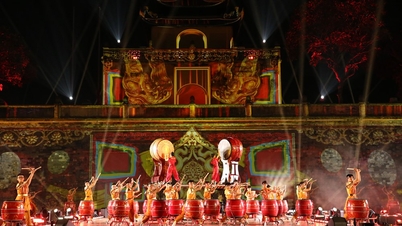




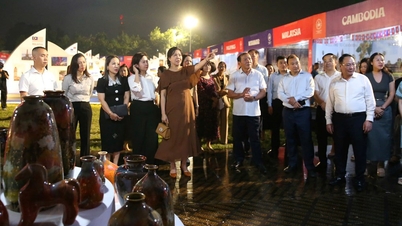











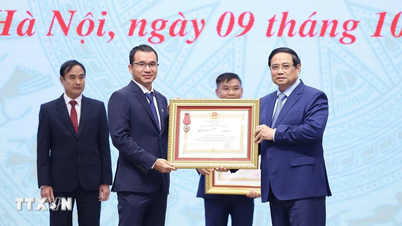


















































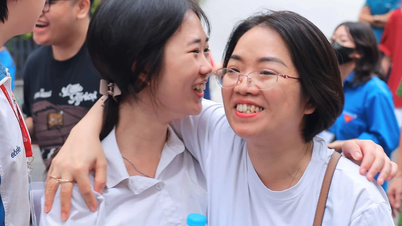















Comment (0)